key FIAT ULYSSE 2007 2.G Workshop Manual
[x] Cancel search | Manufacturer: FIAT, Model Year: 2007, Model line: ULYSSE, Model: FIAT ULYSSE 2007 2.GPages: 254, PDF Size: 3.42 MB
Page 144 of 254
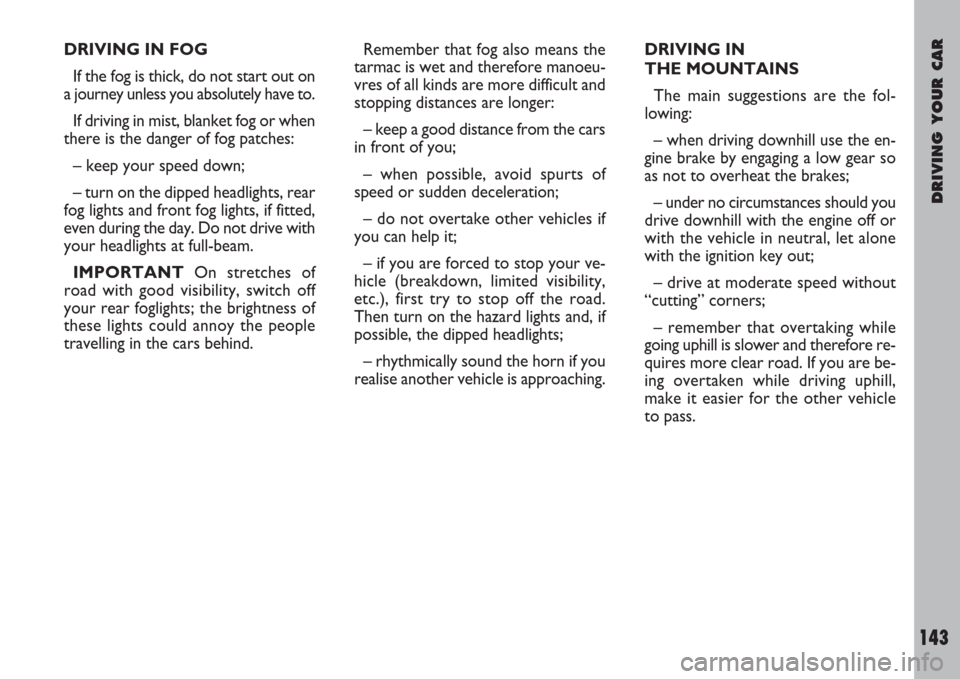
DRIVING YOUR CAR
143
Remember that fog also means the
tarmac is wet and therefore manoeu-
vres of all kinds are more difficult and
stopping distances are longer:
– keep a good distance from the cars
in front of you;
– when possible, avoid spurts of
speed or sudden deceleration;
– do not overtake other vehicles if
you can help it;
– if you are forced to stop your ve-
hicle (breakdown, limited visibility,
etc.), first try to stop off the road.
Then turn on the hazard lights and, if
possible, the dipped headlights;
– rhythmically sound the horn if you
realise another vehicle is approaching.DRIVING IN
THE MOUNTAINS
The main suggestions are the fol-
lowing:
– when driving downhill use the en-
gine brake by engaging a low gear so
as not to overheat the brakes;
– under no circumstances should you
drive downhill with the engine off or
with the vehicle in neutral, let alone
with the ignition key out;
– drive at moderate speed without
“cutting” corners;
– remember that overtaking while
going uphill is slower and therefore re-
quires more clear road. If you are be-
ing overtaken while driving uphill,
make it easier for the other vehicle
to pass. DRIVING IN FOG
If the fog is thick, do not start out on
a journey unless you absolutely have to.
If driving in mist, blanket fog or when
there is the danger of fog patches:
– keep your speed down;
– turn on the dipped headlights, rear
fog lights and front fog lights, if fitted,
even during the day. Do not drive with
your headlights at full-beam.
IMPORTANTOn stretches of
road with good visibility, switch off
your rear foglights; the brightness of
these lights could annoy the people
travelling in the cars behind.
Page 148 of 254
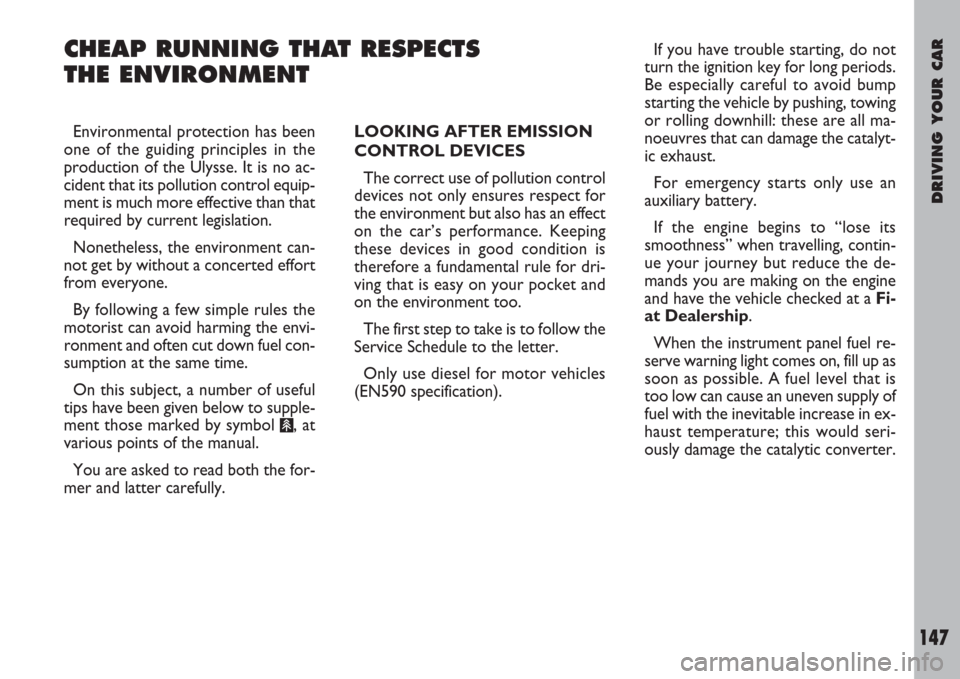
DRIVING YOUR CAR
147
CHEAP RUNNING THAT RESPECTS
THE ENVIRONMENT
LOOKING AFTER EMISSION
CONTROL DEVICES
The correct use of pollution control
devices not only ensures respect for
the environment but also has an effect
on the car’s performance. Keeping
these devices in good condition is
therefore a fundamental rule for dri-
ving that is easy on your pocket and
on the environment too.
The first step to take is to follow the
Service Schedule to the letter.
Only use diesel for motor vehicles
(EN590 specification). Environmental protection has been
one of the guiding principles in the
production of the Ulysse. It is no ac-
cident that its pollution control equip-
ment is much more effective than that
required by current legislation.
Nonetheless, the environment can-
not get by without a concerted effort
from everyone.
By following a few simple rules the
motorist can avoid harming the envi-
ronment and often cut down fuel con-
sumption at the same time.
On this subject, a number of useful
tips have been given below to supple-
ment those marked by symbol
#, at
various points of the manual.
You are asked to read both the for-
mer and latter carefully.If you have trouble starting, do not
turn the ignition key for long periods.
Be especially careful to avoid bump
starting the vehicle by pushing, towing
or rolling downhill: these are all ma-
noeuvres that can damage the catalyt-
ic exhaust.
For emergency starts only use an
auxiliary battery.
If the engine begins to “lose its
smoothness” when travelling, contin-
ue your journey but reduce the de-
mands you are making on the engine
and have the vehicle checked at a Fi-
at Dealership.
When the instrument panel fuel re-
serve warning light comes on, fill up as
soon as possible. A fuel level that is
too low can cause an uneven supply of
fuel with the inevitable increase in ex-
haust temperature; this would seri-
ously damage the catalytic converter.
Page 154 of 254
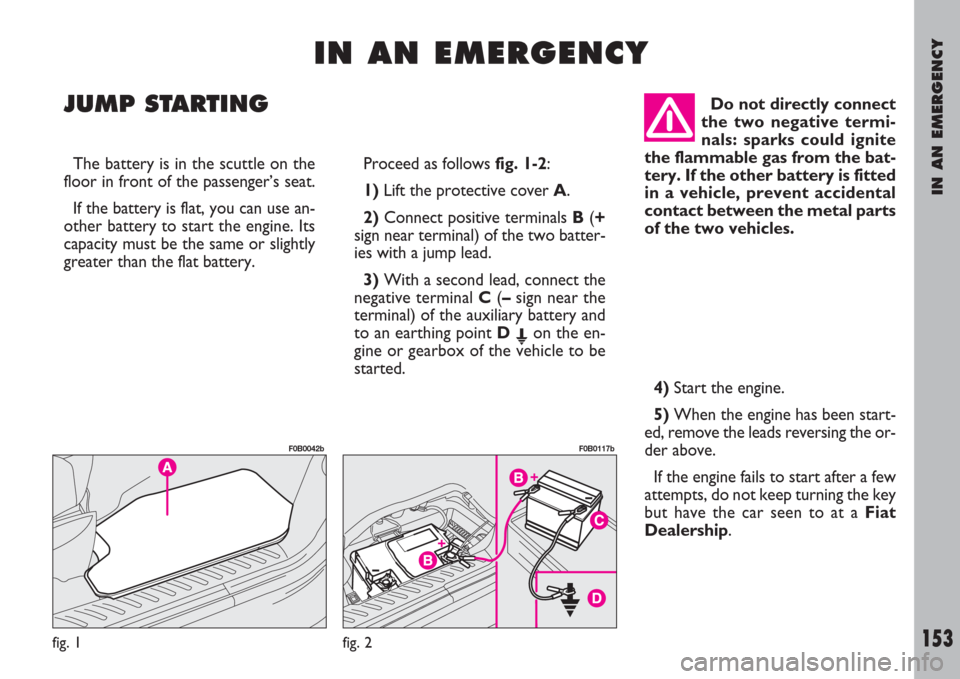
IN AN EMERGENCY
153
I I
N N
A A
N N
E E
M M
E E
R R
G G
E E
N N
C C
Y Y
JUMP STARTING
Proceed as follows fig. 1-2:
1)Lift the protective cover A.
2)Connect positive terminals B(+
sign near terminal) of the two batter-
ies with a jump lead.
3)With a second lead, connect the
negative terminal C(–sign near the
terminal) of the auxiliary battery and
to an earthing point DEon the en-
gine or gearbox of the vehicle to be
started. The battery is in the scuttle on the
floor in front of the passenger’s seat.
If the battery is flat, you can use an-
other battery to start the engine. Its
capacity must be the same or slightly
greater than the flat battery.Do not directly connect
the two negative termi-
nals: sparks could ignite
the flammable gas from the bat-
tery. If the other battery is fitted
in a vehicle, prevent accidental
contact between the metal parts
of the two vehicles.
4)Start the engine.
5)When the engine has been start-
ed, remove the leads reversing the or-
der above.
If the engine fails to start after a few
attempts, do not keep turning the key
but have the car seen to at a Fiat
Dealership.
fig. 1
F0B0042b
fig. 2
F0B0117b
Page 172 of 254
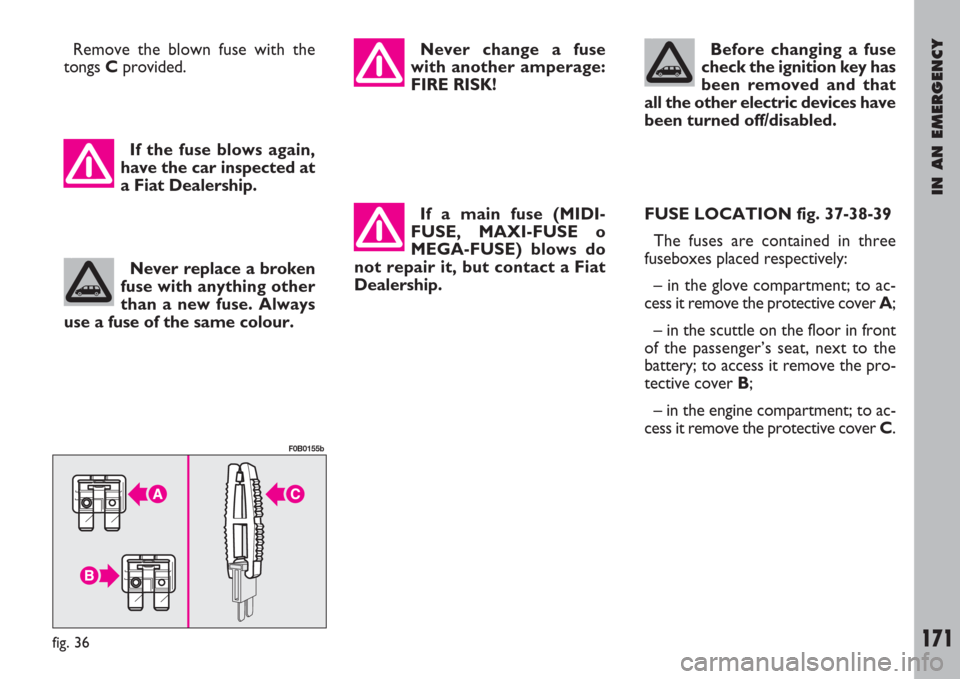
IN AN EMERGENCY
171
Remove the blown fuse with the
tongs Cprovided.
If a main fuse (MIDI-
FUSE, MAXI-FUSE o
MEGA-FUSE) blows do
not repair it, but contact a Fiat
Dealership.FUSE LOCATION fig. 37-38-39
The fuses are contained in three
fuseboxes placed respectively:
– in the glove compartment; to ac-
cess it remove the protective cover A;
– in the scuttle on the floor in front
of the passenger’s seat, next to the
battery; to access it remove the pro-
tective cover B;
– in the engine compartment; to ac-
cess it remove the protective cover C. Never replace a broken
fuse with anything other
than a new fuse. Always
use a fuse of the same colour.Before changing a fuse
check the ignition key has
been removed and that
all the other electric devices have
been turned off/disabled.Never change a fuse
with another amperage:
FIRE RISK!
fig. 36
F0B0155b
If the fuse blows again,
have the car inspected at
a Fiat Dealership.
Page 177 of 254
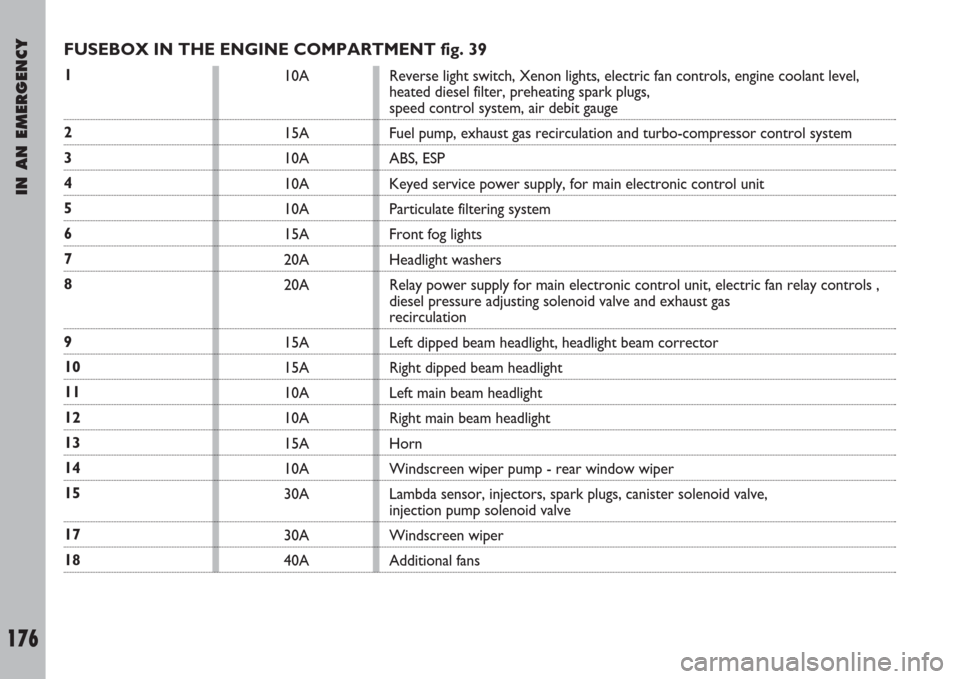
IN AN EMERGENCY
176
FUSEBOX IN THE ENGINE COMPARTMENT fig. 39
1
2
3
4
5
6
7
8
9
10
11
12
13
14
15
17
1810A
15A
10A
10A
10A
15A
20A
20A
15A
15A
10A
10A
15A
10A
30A
30A
40AReverse light switch, Xenon lights, electric fan controls, engine coolant level,
heated diesel filter, preheating spark plugs,
speed control system, air debit gauge
Fuel pump, exhaust gas recirculation and turbo-compressor control system
ABS, ESP
Keyed service power supply, for main electronic control unit
Particulate filtering system
Front fog lights
Headlight washers
Relay power supply for main electronic control unit, electric fan relay controls ,
diesel pressure adjusting solenoid valve and exhaust gas
recirculation
Left dipped beam headlight, headlight beam corrector
Right dipped beam headlight
Left main beam headlight
Right main beam headlight
Horn
Windscreen wiper pump - rear window wiper
Lambda sensor, injectors, spark plugs, canister solenoid valve,
injection pump solenoid valve
Windscreen wiper
Additional fans
Page 182 of 254
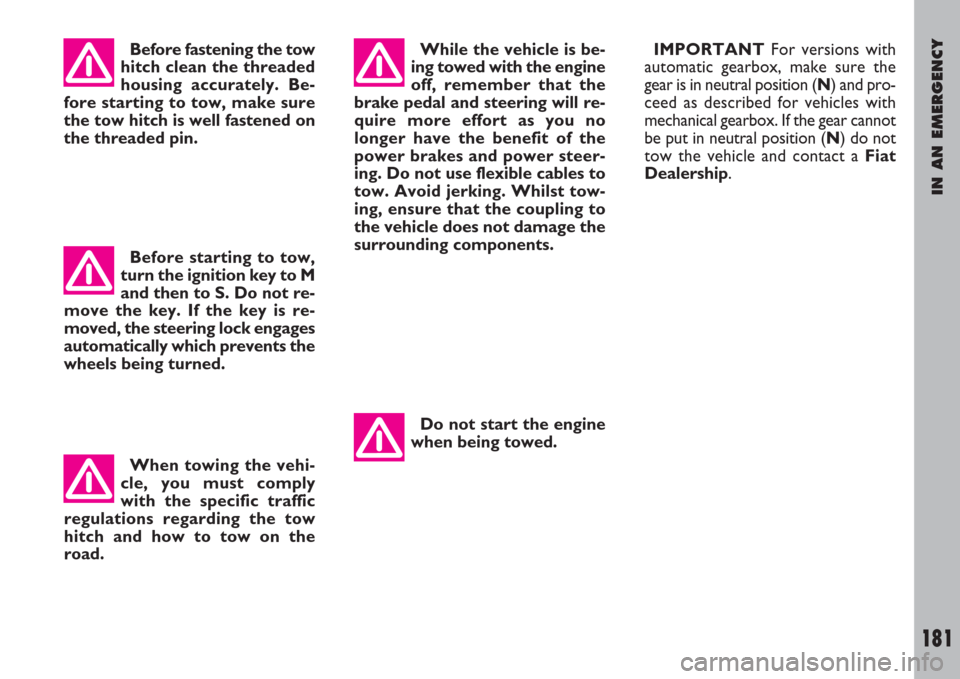
IN AN EMERGENCY
181
Before fastening the tow
hitch clean the threaded
housing accurately. Be-
fore starting to tow, make sure
the tow hitch is well fastened on
the threaded pin.While the vehicle is be-
ing towed with the engine
off, remember that the
brake pedal and steering will re-
quire more effort as you no
longer have the benefit of the
power brakes and power steer-
ing. Do not use flexible cables to
tow. Avoid jerking. Whilst tow-
ing, ensure that the coupling to
the vehicle does not damage the
surrounding components.IMPORTANTFor versions with
automatic gearbox, make sure the
gear is in neutral position (N) and pro-
ceed as described for vehicles with
mechanical gearbox. If the gear cannot
be put in neutral position (N) do not
tow the vehicle and contact a Fiat
Dealership.
Before starting to tow,
turn the ignition key to M
and then to S. Do not re-
move the key. If the key is re-
moved, the steering lock engages
automatically which prevents the
wheels being turned.
When towing the vehi-
cle, you must comply
with the specific traffic
regulations regarding the tow
hitch and how to tow on the
road.
Do not start the engine
when being towed.
Page 183 of 254
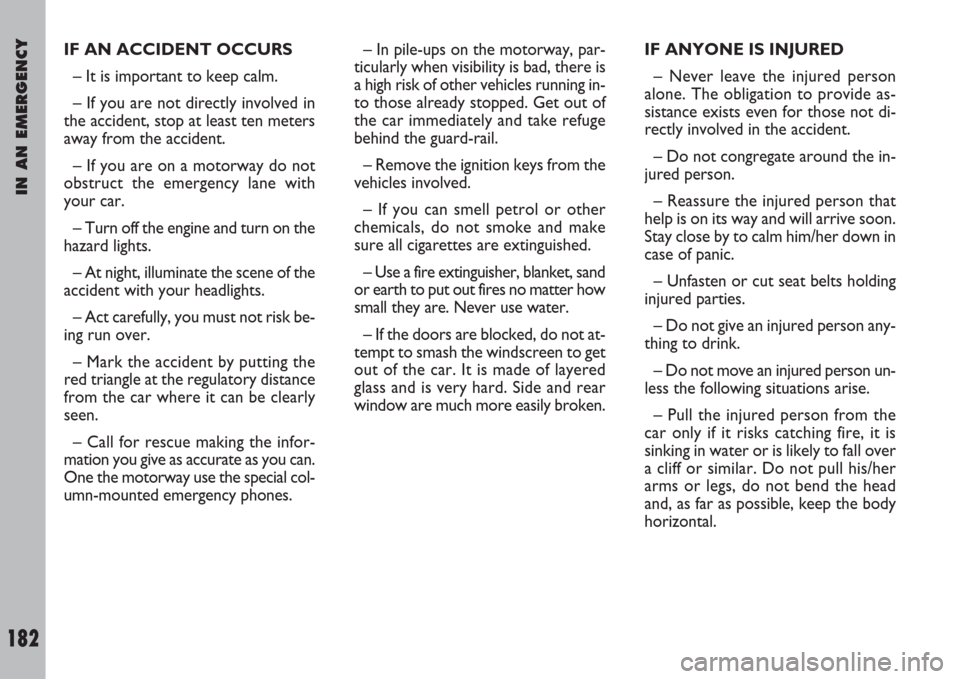
IN AN EMERGENCY
182
IF AN ACCIDENT OCCURS
– It is important to keep calm.
– If you are not directly involved in
the accident, stop at least ten meters
away from the accident.
– If you are on a motorway do not
obstruct the emergency lane with
your car.
– Turn off the engine and turn on the
hazard lights.
– At night, illuminate the scene of the
accident with your headlights.
– Act carefully, you must not risk be-
ing run over.
– Mark the accident by putting the
red triangle at the regulatory distance
from the car where it can be clearly
seen.
– Call for rescue making the infor-
mation you give as accurate as you can.
One the motorway use the special col-
umn-mounted emergency phones.– In pile-ups on the motorway, par-
ticularly when visibility is bad, there is
a high risk of other vehicles running in-
to those already stopped. Get out of
the car immediately and take refuge
behind the guard-rail.
– Remove the ignition keys from the
vehicles involved.
– If you can smell petrol or other
chemicals, do not smoke and make
sure all cigarettes are extinguished.
– Use a fire extinguisher, blanket, sand
or earth to put out fires no matter how
small they are. Never use water.
– If the doors are blocked, do not at-
tempt to smash the windscreen to get
out of the car. It is made of layered
glass and is very hard. Side and rear
window are much more easily broken.IF ANYONE IS INJURED
– Never leave the injured person
alone. The obligation to provide as-
sistance exists even for those not di-
rectly involved in the accident.
– Do not congregate around the in-
jured person.
– Reassure the injured person that
help is on its way and will arrive soon.
Stay close by to calm him/her down in
case of panic.
– Unfasten or cut seat belts holding
injured parties.
– Do not give an injured person any-
thing to drink.
– Do not move an injured person un-
less the following situations arise.
– Pull the injured person from the
car only if it risks catching fire, it is
sinking in water or is likely to fall over
a cliff or similar. Do not pull his/her
arms or legs, do not bend the head
and, as far as possible, keep the body
horizontal.
Page 205 of 254
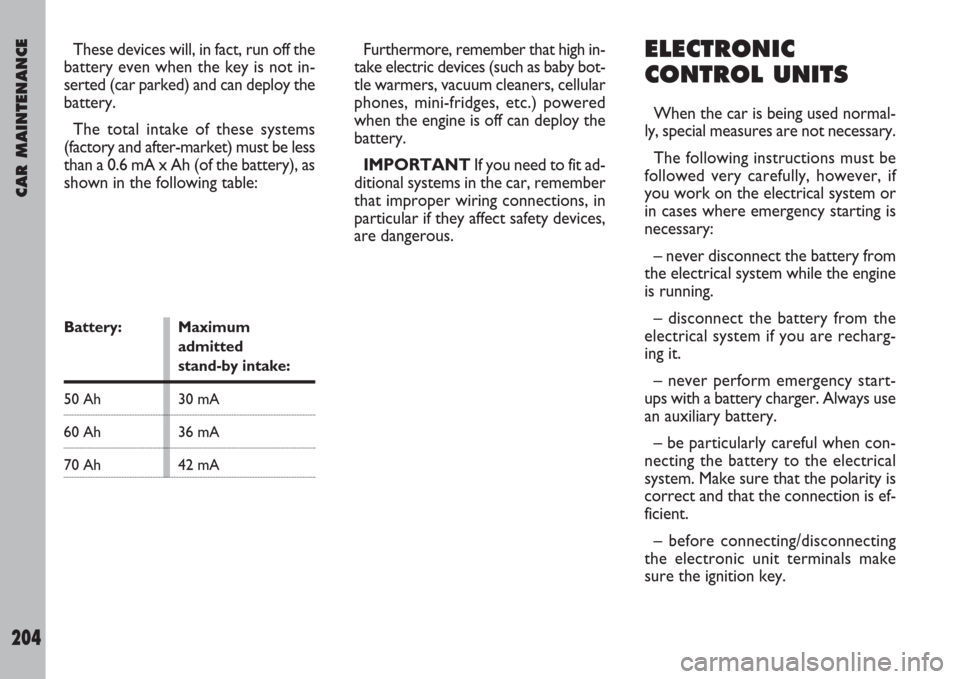
CAR MAINTENANCE
204
These devices will, in fact, run off the
battery even when the key is not in-
serted (car parked) and can deploy the
battery.
The total intake of these systems
(factory and after-market) must be less
than a 0.6 mA x Ah (of the battery), as
shown in the following table:
Battery:
50 Ah
60 Ah
70 AhMaximum
admitted
stand-by intake:
30 mA
36 mA
42 mA
Furthermore, remember that high in-
take electric devices (such as baby bot-
tle warmers, vacuum cleaners, cellular
phones, mini-fridges, etc.) powered
when the engine is off can deploy the
battery.
IMPORTANTIf you need to fit ad-
ditional systems in the car, remember
that improper wiring connections, in
particular if they affect safety devices,
are dangerous.ELECTRONIC
CONTROL UNITS
When the car is being used normal-
ly, special measures are not necessary.
The following instructions must be
followed very carefully, however, if
you work on the electrical system or
in cases where emergency starting is
necessary:
– never disconnect the battery from
the electrical system while the engine
is running.
– disconnect the battery from the
electrical system if you are recharg-
ing it.
– never perform emergency start-
ups with a battery charger. Always use
an auxiliary battery.
– be particularly careful when con-
necting the battery to the electrical
system. Make sure that the polarity is
correct and that the connection is ef-
ficient.
– before connecting/disconnecting
the electronic unit terminals make
sure the ignition key.
Page 209 of 254
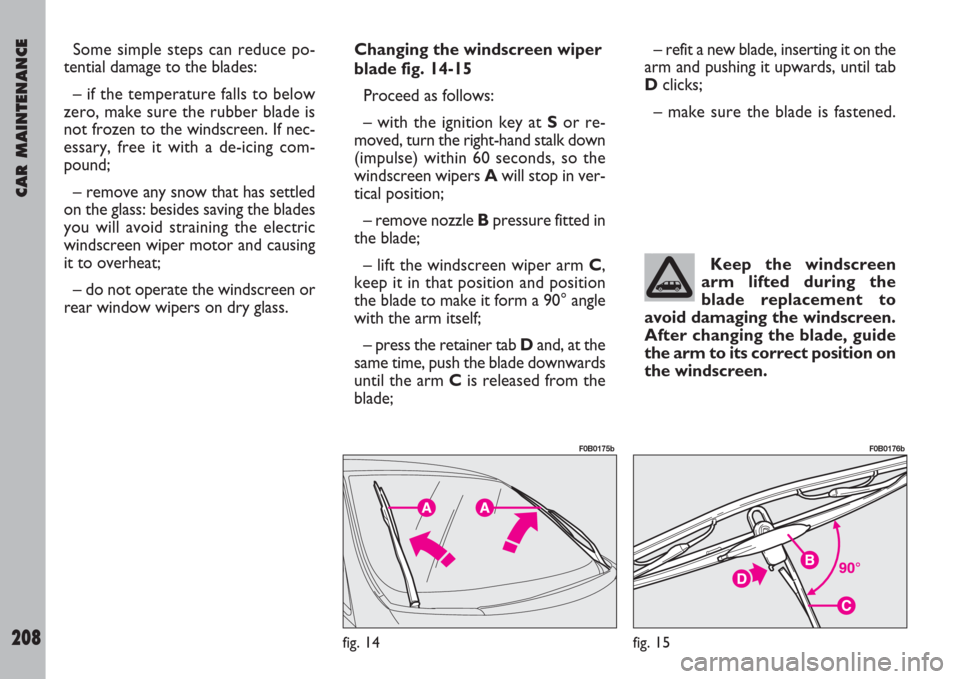
CAR MAINTENANCE
208
Some simple steps can reduce po-
tential damage to the blades:
– if the temperature falls to below
zero, make sure the rubber blade is
not frozen to the windscreen. If nec-
essary, free it with a de-icing com-
pound;
– remove any snow that has settled
on the glass: besides saving the blades
you will avoid straining the electric
windscreen wiper motor and causing
it to overheat;
– do not operate the windscreen or
rear window wipers on dry glass.Changing the windscreen wiper
blade fig. 14-15
Proceed as follows:
– with the ignition key at Sor re-
moved, turn the right-hand stalk down
(impulse) within 60 seconds, so the
windscreen wipers Awill stop in ver-
tical position;
– remove nozzle Bpressure fitted in
the blade;
– lift the windscreen wiper arm C,
keep it in that position and position
the blade to make it form a 90° angle
with the arm itself;
– press the retainer tab Dand, at the
same time, push the blade downwards
until the arm Cis released from the
blade;– refit a new blade, inserting it on the
arm and pushing it upwards, until tab
D clicks;
– make sure the blade is fastened.
Keep the windscreen
arm lifted during the
blade replacement to
avoid damaging the windscreen.
After changing the blade, guide
the arm to its correct position on
the windscreen.
fig. 14
F0B0175b
fig. 15
F0B0176b
Page 213 of 254
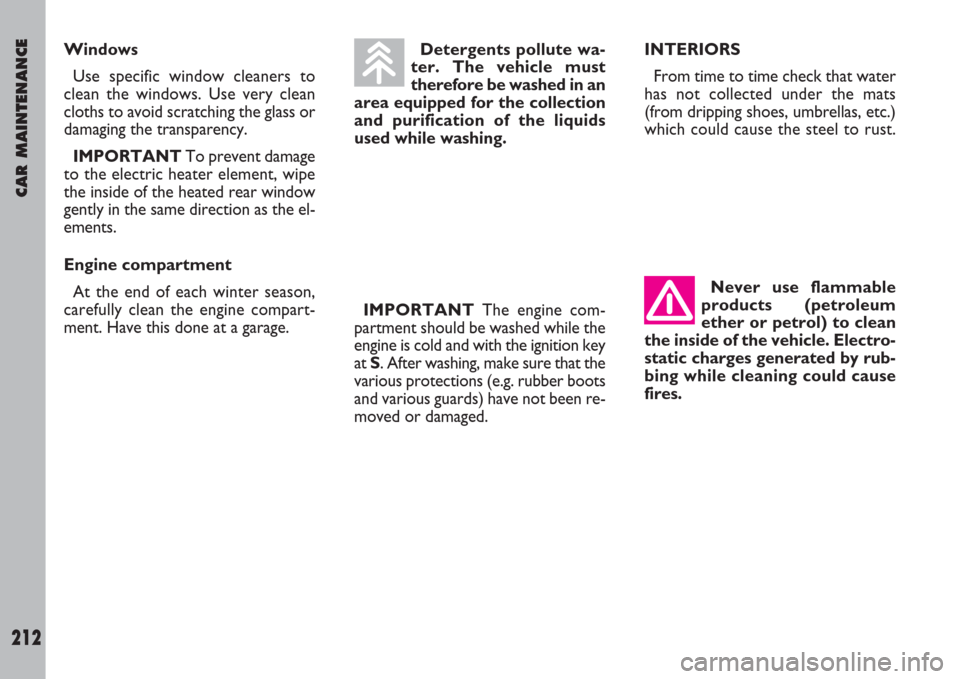
CAR MAINTENANCE
212
Windows
Use specific window cleaners to
clean the windows. Use very clean
cloths to avoid scratching the glass or
damaging the transparency.
IMPORTANT To prevent damage
to the electric heater element, wipe
the inside of the heated rear window
gently in the same direction as the el-
ements.
Engine compartment
At the end of each winter season,
carefully clean the engine compart-
ment. Have this done at a garage.IMPORTANTThe engine com-
partment should be washed while the
engine is cold and with the ignition key
at S. After washing, make sure that the
various protections (e.g. rubber boots
and various guards) have not been re-
moved or damaged.INTERIORS
From time to time check that water
has not collected under the mats
(from dripping shoes, umbrellas, etc.)
which could cause the steel to rust. Detergents pollute wa-
ter. The vehicle must
therefore be washed in an
area equipped for the collection
and purification of the liquids
used while washing.
Never use flammable
products (petroleum
ether or petrol) to clean
the inside of the vehicle. Electro-
static charges generated by rub-
bing while cleaning could cause
fires.